#2 July 1863
Text










The Second Day of the Battle of Gettysburg was on July 2, 1863.
#Second Day of the Battle of Gettysburg#2 July 1863#160th anniversary#US history#travel#original photography#vacation#tourist attraction#landmark#landscape#countryside#summer 2019#Gettysburg Battlefield Historic District#Gettysburg National Military Park#US Civil War#American Civil War#Devil's Den#Little Round Top#free admission#cannon#flora#nature#Pennsylvania#USA
14 notes
·
View notes
Text

In 2020, the Danish survey vessel Deneb found an unusual wreck in the Kadet Trench in the Baltic Sea. The ship, built in 1847 as the Earl of Rosslyn by Smith & Rodger Govan Middleton Yard in Glasgow, Scotland, and later renamed Friedrich Franz II (Grand Duke of Mecklenburg 1823 - 1863), was a sidewheel steamer and not only had a type of steam engine that was new for its time. It was also one of the first ships to be built entirely of iron.

Side Sonar picture of the wreck
The ship sank after colliding with the steamship Lübeck on the night of 22 July 1849 within 45 minutes, killing 2 of the 6 passengers. According to the responsible researchers, the wreck will not be salvaged, but preserved permanently as a monument on the bottom of the Baltic Sea.
128 notes
·
View notes
Text
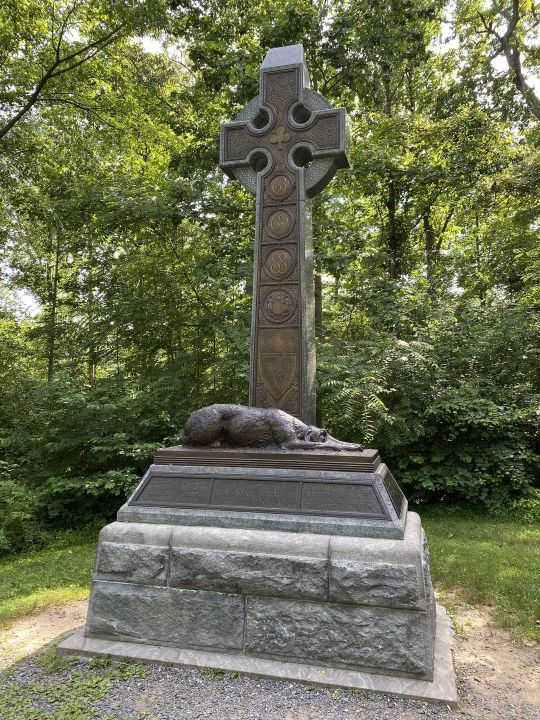
GETTYSBURG — Located inside the Rose Woods, the monument to the Irish Brigade was dedicated in 1888. Fighting in and around The Wheatfield on July 2, 1863, this famed fighting unit under the command of Colonel Patrick Kelly consisted of the 63rd, 69th, and 88th New York Infantry Regiments, along with the 28th Massachusetts and 116th Pennsylvania. The monument features a Celtic cross and a life sized Irish wolfhound.
53 notes
·
View notes
Text
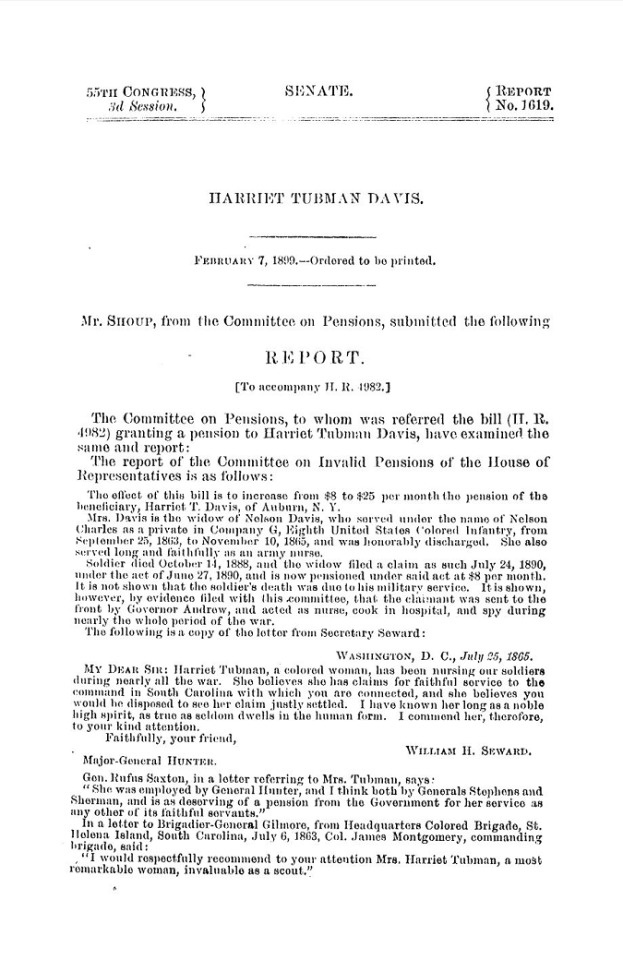
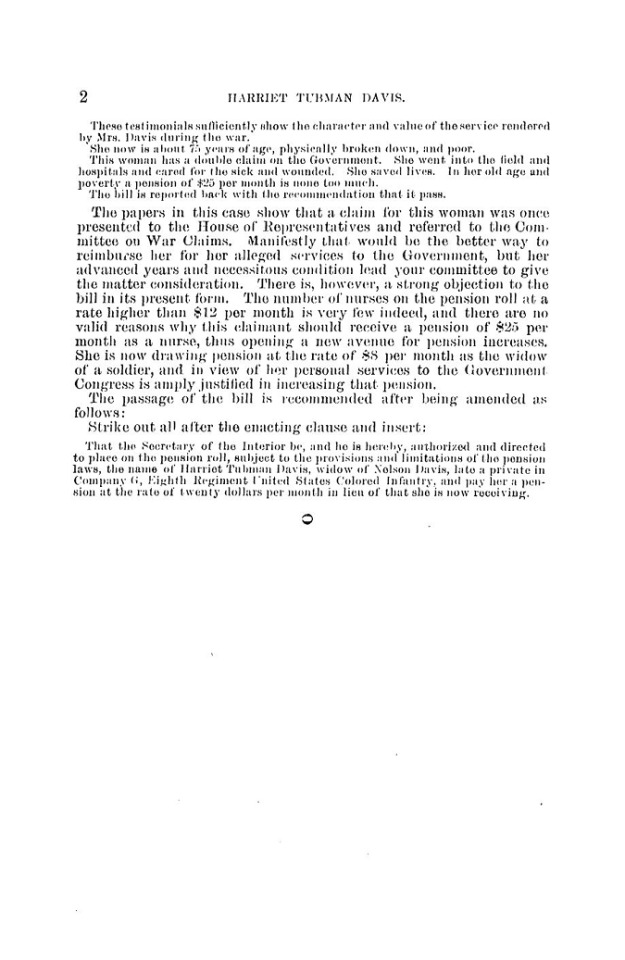
Senate Report 1619 to Accompany a Bill Granting a Pension to Harriet Tubman Davis
Record Group 233: Records of the U.S. House of RepresentativesSeries: Accompanying PapersFile Unit: Accompanying Papers of the 55th Congress
55th Congress, 3d Session. Senate Report No. 1619. HARRIET TUBMAN DAVIS. FEBRUARY 7, 1899. - Ordered to be printed. Mr. SHOUP, from the Committee on Pensions, submitted the following REPORT. [To accompany H. R. 4982.] The Committee on Pensions, to whom was referred the bill (H. R. 4892) granting a pension to Harriet Tubman Davis, have examined the same and report: The report of the Committee on Invalid Pensions of the House of Representatives is as follows: The effect of this bill is to increase from $8 to $25 per month the pension of the beneficiary, Harriet T. Davis, of Auburn, N. Y. Mrs. Davis is the widow of Nelson Davis, who served under the name of Nelson Charles as a private in Company G, Eighth United States Colored Infantry, from September 25, 1863, to November 10, 1865, and was honorably discharged. She also served long and faithfully as an army nurse. Soldier died October 14, 1888, and the widow filed a claim as such July 24, 1890, under the act of June 27, 1890, and is now pensioned under said act at $8 per month. It is not shown that the soldier's death was due to his military service. It is shown, however, by evidence filed with this committee, that the claimant was sent to the front by Governor Andrew, and acted as a nurse, cook in hospital, and spy during nearly the whole period of the war. The following is a copy of the letter from Secretary Seward: WASHINGTON, D. C., July 25, 1865. MY DEAR SIR: Harriet Tubman, a colored woman, has been nursing our soldiers during nearly all the war. She believes she has claims for faithful service to the command in South Carolina with which you are connected, and she believes you would be disposed to see her claim justly settled. I have known her long as a noble high spirit, as true as seldom dwells in the human form. I commend her, therefore, to your kind attention. Faithfully, your friend, WILLIAM H. SEWARD. Major-General HUNTER. Gen. Rufus Saxton, in a letter referring to Mrs. Tubman, says: "She was employed by General Hunter, and I think both by General Stephens and Sherman, and is as deserving of a pension from the Government for her service as any other of its faithful servants." In a letter to Brigadier-General Gilmore, from Headquarters Colored Brigade, St. Helena Island, South Carolina, July 6, 1863, Col. James Montgomery, commanding brigade, said: "I would respectfully recommend to your attention Mrs. Harriet Tubman, a most remarkable women, invaluable as a scout."2 HARRIET TUBMAN DAVIS. These testimonials sufficiently show the character and value of the service rendered by Mrs, Davis during the war. She now is about 75 years of age, physically broken down, and poor. This woman has a double claim on the Government. She went into the field and hospitals and cared for the sick and wounded. She saved lives. In her old age and poverty a pension of $25 per month is none too much. The bill is reported back with the recommendation that it pass. The papers in this case show that a claim for this woman was once presented to the House of Representatives and referred to the Committee on War Claims. Manifestly that would be the better way to reimburse her for her alleged services to the Government, but her advanced years and necessitous condition lead your committee to give the matter consideration. There is, however, a strong objection to the bill in its present form. The number of nurses on the pension roll at a rate higher than $12 per month is very few indeed, and there are no valid reasons why this claimant should receive a pension of $25 per month as a nurse, thus opening a new avenue for pension increases. She is now drawing pension at the rate of $8 per month as the widow of a soldier, and in view of her personal services to the Government Congress is amply justified in increasing that pension. [full transcription at link]
27 notes
·
View notes
Text

De maanden 2 - 07 Juli. Theodoor van Hoytema (1863-1917)
via
330 notes
·
View notes
Text
The napoleonic marshal‘s children
After seeing @josefavomjaaga’s and @northernmariette’s marshal calendar, I wanted to do a similar thing for all the marshal’s children! So I did! I hope you like it. c:
I listed them in more or less chronological order but categorised them in years (especially because we don‘t know all their birthdays).
At the end of this post you are going to find remarks about some of the marshals because not every child is listed! ^^“
To the question about the sources: I mostly googled it and searched their dates in Wikipedia, ahaha. Nevertheless, I also found this website. However, I would be careful with it. We are talking about history and different sources can have different dates.
I am always open for corrections. Just correct me in the comments if you find or know a trustful source which would show that one or some of the dates are incorrect.
At the end of the day it is harmless fun and research. :)
Pre 1790
François Étienne Kellermann (4 August 1770- 2 June 1835)
Marguerite Cécile Kellermann (15 March 1773 - 12 August 1850)
Ernestine Grouchy (1787–1866)
Mélanie Marie Josèphe de Pérignon (1788 - 1858)
Alphonse Grouchy (1789–1864)
Jean-Baptiste Sophie Pierre de Pérignon (1789- 14 January 1807)
Marie Françoise Germaine de Pérignon (1789 - 15 May 1844)
Angélique Catherine Jourdan (1789 or 1791 - 7 March 1879)
1790 - 1791
Marie-Louise Oudinot (1790–1832)
Marie-Anne Masséna (8 July 1790 - 1794)
Charles Oudinot (1791 - 1863)
Aimee-Clementine Grouchy (1791–1826)
Anne-Francoise Moncey (1791–1842)
1792 - 1793
Bon-Louis Moncey (1792–1817)
Victorine Perrin (1792–1822)
Anne-Charlotte Macdonald (1792–1870)
François Henri de Pérignon (23 February 1793 - 19 October 1841)
Jacques Prosper Masséna (25 June 1793 - 13 May 1821)
1794 - 1795
Victoire Thècle Masséna (28 September 1794 - 18 March 1857)
Adele-Elisabeth Macdonald (1794–1822)
Marguerite-Félécité Desprez (1795-1854); adopted by Sérurier
Nicolette Oudinot (1795–1865)
Charles Perrin (1795–15 March 1827)
1796 - 1997
Emilie Oudinot (1796–1805)
Victor Grouchy (1796–1864)
Napoleon-Victor Perrin (24 October 1796 - 2 December 1853)
Jeanne Madeleine Delphine Jourdan (1797-1839)
1799
François Victor Masséna (2 April 1799 - 16 April 1863)
Joseph François Oscar Bernadotte (4 July 1799 – 8 July 1859)
Auguste Oudinot (1799–1835)
Caroline de Pérignon (1799-1819)
Eugene Perrin (1799–1852)
1800
Nina Jourdan (1800-1833)
Caroline Mortier de Trevise (1800–1842)
1801
Achille Charles Louis Napoléon Murat (21 January 1801 - 15 April 1847)
Louis Napoléon Lannes (30 July 1801 – 19 July 1874)
Elise Oudinot (1801–1882)
1802
Marie Letizia Joséphine Annonciade Murat (26 April 1802 - 12 March 1859)
Alfred-Jean Lannes (11 July 1802 – 20 June 1861)
Napoléon Bessière (2 August 1802 - 21 July 1856)
Paul Davout (1802–1803)
Napoléon Soult (1802–1857)
1803
Marie-Agnès Irma de Pérignon (5 April 1803 - 16 December 1849)
Joseph Napoléon Ney (8 May 1803 – 25 July 1857)
Lucien Charles Joseph Napoléon Murat (16 May 1803 - 10 April 1878)
Jean-Ernest Lannes (20 July 1803 – 24 November 1882)
Alexandrine-Aimee Macdonald (1803–1869)
Sophie Malvina Joséphine Mortier de Trévise ( 1803 - ???)
1804
Napoléon Mortier de Trévise (6 August 1804 - 29 December 1869)
Michel Louis Félix Ney (24 August 1804 – 14 July 1854)
Gustave-Olivier Lannes (4 December 1804 – 25 August 1875)
Joséphine Davout (1804–1805)
Hortense Soult (1804–1862)
Octavie de Pérignon (1804-1847)
1805
Louise Julie Caroline Murat (21 March 1805 - 1 December 1889)
Antoinette Joséphine Davout (1805 – 19 August 1821)
Stephanie-Josephine Perrin (1805–1832)
1806
Josephine-Louise Lannes (4 March 1806 – 8 November 1889)
Eugène Michel Ney (12 July 1806 – 25 October 1845)
Edouard Moriter de Trévise (1806–1815)
Léopold de Pérignon (1806-1862)
1807
Adèle Napoleone Davout (June 1807 – 21 January 1885)
Jeanne-Francoise Moncey (1807–1853)
1808: Stephanie Oudinot (1808-1893)
1809: Napoleon Davout (1809–1810)
1810: Napoleon Alexander Berthier (11 September 1810 – 10 February 1887)
1811
Napoleon Louis Davout (6 January 1811 - 13 June 1853)
Louise-Honorine Suchet (1811 – 1885)
Louise Mortier de Trévise (1811–1831)
1812
Edgar Napoléon Henry Ney (12 April 1812 – 4 October 1882)
Caroline-Joséphine Berthier (22 August 1812 – 1905)
Jules Davout (December 1812 - 1813)
1813: Louis-Napoleon Suchet (23 May 1813- 22 July 1867/77)
1814: Eve-Stéphanie Mortier de Trévise (1814–1831)
1815
Marie Anne Berthier (February 1815 - 23 July 1878)
Adelaide Louise Davout (8 July 1815 – 6 October 1892)
Laurent François or Laurent-Camille Saint-Cyr (I found two almost similar names with the same date so) (30 December 1815 – 30 January 1904)
1816: Louise Marie Oudinot (1816 - 1909)
1817
Caroline Oudinot (1817–1896)
Caroline Soult (1817–1817)
1819: Charles-Joseph Oudinot (1819–1858)
1820: Anne-Marie Suchet (1820 - 27 May 1835)
1822: Henri Oudinot ( 3 February 1822 – 29 July 1891)
1824: Louis Marie Macdonald (11 November 1824 - 6 April 1881.)
1830: Noemie Grouchy (1830–1843)
——————
Children without clear birthdays:
Camille Jourdan (died in 1842)
Sophie Jourdan (died in 1820)
Additional remarks:
- Marshal Berthier died 8.5 months before his last daughter‘s birth.
- Marshal Oudinot had 11 children and the age difference between his first and last child is around 32 years.
- The age difference between marshal Grouchy‘s first and last child is around 43 years.
- Marshal Lefebvre had fourteen children (12 sons, 2 daughters) but I couldn‘t find anything kind of reliable about them so they are not listed above. I am aware that two sons of him were listed in the link above. Nevertheless, I was uncertain to name them in my list because I thought that his last living son died in the Russian campaign while the website writes about the possibility of another son dying in 1817.
- Marshal Augerau had no children.
- Marshal Brune had apparently adopted two daughters whose names are unknown.
- Marshal Pérignon: I couldn‘t find anything about his daughters, Justine, Elisabeth and Adèle, except that they died in infancy.
- Marshal Sérurier had no biological children but adopted Marguerite-Félécité Desprez in 1814.
- Marshal Marmont had no children.
- I found out that marshal Saint-Cyr married his first cousin, lol.
- I didn‘t find anything about marshal Poniatowski having children. Apparently, he wasn‘t married either (thank you, @northernmariette for the correction of this fact! c:)
#Marshal‘s children calendar#literally every napoleonic marshal ahaha#napoleonic era#Napoleonic children#I am not putting all the children‘s names into the tags#Thank you no thank you! :)#YES I posted it without double checking every child so don‘t be surprised when I have to correct some stuff 😭#napoleon's marshals#napoleonic
66 notes
·
View notes
Text










The Battle of Gettysburg 160th Anniversary
"In July 1863
A nation torn in tragedy
A trick of fate, two great armies merge
Gods of war at Gettysburg
Devastation lies ahead
50, 000 bodies litter the land
Hell rages three full days
The reaper sows, there's the devil to pay"
- The Devil to Pay, Iced Earth
*************************************
The Battle of Gettysburg:
Day 1
Day 2
Day 3
----------------------------------------
The battle of Gettysburg is more than just a single battle. It was a series of engagements spanning three days. The events that occured during that fight could not be all told in ten art pieces alone. Stories such as the charge of the 1st Minnesota, the 137th New York's defense of the Union right flank, the fight at East Cavalry Field, and many other stories that happened during those three days were, sadly, not told here. However, it is my hope that this gave some awareness to the battle and the sacrifices made by the soldies who fought that day.
Special thanks to all those who were featured!
@temper-temper
@randomgurustuffs
@askpokeeosin
@whirlwindflux
@flashmod
@a-spoonful-o-generosity
@thedumbguywithaheart43
@bexdrey
@techbro-arts
@duran301
@fetch26291
@daintydoilypon
@thelunararmy
@ask-space-race
@f0rever-autumn
@hoofclid
@nox-lunarwing
@ama-artistic
@nopony-ask-mclovin
@asktwilighteclipse
@ask-healthy-light
#Art#MLP#My Little Pony#History#Gettysburg#Battle of Gettysburg#Gettysburg 160#Gettysburg 160th Anniversary
34 notes
·
View notes
Text
Wikipedia Featured Article Poll, Biographies Edition. Summaries and links below the cut
Margaret Ives Abbott (June 15, 1878 – June 10, 1955) was an American amateur golfer. She was the first American woman to win an Olympic event: the women's golf tournament at the 1900 Summer Olympics.
Lilias Eveline Armstrong (29 September 1882 – 9 December 1937) was an English phonetician. She worked at University College London, where she attained the rank of reader. Armstrong is most known for her work on English intonation as well as the phonetics and tone of Somali and Kikuyu. Her book on English intonation, written with Ida C. Ward, was in print for 50 years. Armstrong also provided some of the first detailed descriptions of tone in Somali and Kikuyu.
Morris Berg (March 2, 1902 – May 29, 1972) was an American catcher and coach in Major League Baseball, who later served as a spy for the Office of Strategic Services during World War II. Although he played 15 seasons in the major leagues, almost entirely for four American League teams, Berg was never more than an average player and was better known for being "the brainiest guy in baseball." Casey Stengel once described Berg as "the strangest man ever to play baseball".
Edward Dando (c. 1803 – 28 August 1832) was a thief who came to public notice in Britain because of his unusual habit of overeating at food stalls and inns, and then revealing that he had no money to pay. Although the fare he consumed was varied, he was particularly fond of oysters, having once eaten 25 dozen of them with a loaf and a half of bread with butter.
Harold Francis Davidson (14 July 1875 – 30 July 1937), generally known as the Rector of Stiffkey, was a Church of England priest who in 1932, after a public scandal, was convicted of immorality by a church court and defrocked. Davidson strongly protested his innocence and to raise funds for his reinstatement campaign he exhibited himself in a barrel on the Blackpool seafront. He performed in other sideshows of a similar nature, and died after being attacked by a lion in whose cage he was appearing in a seaside spectacular.
Marjory Stoneman Douglas (April 7, 1890 – May 14, 1998) was an American journalist, author, women's suffrage advocate, and conservationist known for her staunch defense of the Everglades against efforts to drain it and reclaim land for development. Moving to Miami as a young woman to work for The Miami Herald, she became a freelance writer, producing over one hundred short stories that were published in popular magazines. Her most influential work was the book The Everglades: River of Grass (1947), which redefined the popular conception of the Everglades as a treasured river instead of a worthless swamp. Its impact has been compared to that of Rachel Carson's influential book Silent Spring (1962). Her books, stories, and journalism career brought her influence in Miami, enabling her to advance her causes.
George Went Hensley (May 2, 1881 – July 25, 1955) was an American Pentecostal minister best known for popularizing the practice of snake handling. A native of rural Appalachia, Hensley experienced a religious conversion around 1910: on the basis of his interpretation of scripture, he came to believe that the New Testament commanded all Christians to handle venomous snakes.
Margaret Alice Murray FSA Scot FRAI (13 July 1863 – 13 November 1963) was a British-Indian Egyptologist, archaeologist, anthropologist, historian, and folklorist who was born in India. The first woman to be appointed as a lecturer in archaeology in the United Kingdom, she worked at University College London (UCL) from 1898 to 1935. She served as president of the Folklore Society from 1953 to 1955, and published widely over the course of her career.
Dom Pedro Afonso (19 July 1848 – 10 January 1850) was the Prince Imperial and heir apparent to the throne of the Empire of Brazil. Born at the Palace of São Cristóvão in Rio de Janeiro, he was the second son and youngest child of Emperor Dom Pedro II and Dona Teresa Cristina of the Two Sicilies, and thus a member of the Brazilian branch of the House of Braganza. Pedro Afonso was seen as vital to the future viability of the monarchy, which had been put in jeopardy by the death of his older brother Dom Afonso almost three years earlier.
Elias Abraham Rosenberg (Hebrew: אליאס אברהם רוזנברג; Hawaiian: Eliaka Apelahama Loselabeka; c. 1810 – July 10, 1887) was a Jewish immigrant to the United States who, despite a questionable past, became a trusted friend and adviser of King Kalākaua of Hawaii. Regarded as eccentric, he lived in San Francisco in the 1880s and worked as a peddler selling illegal lottery tickets. In 1886, he traveled to Hawaii and performed as a fortune-teller. He came to Kalākaua's attention, and endeared himself to the king with favorable predictions about the future of Hawaii. Rosenberg received royal appointments to several positions: kahuna-kilokilo (royal soothsayer), customs appraiser, and guard. He was given lavish gifts by the king, but was mistrusted by other royal advisers and satirized in the Hawaiian press.
#i expanded the summaries from the first sentence of the article to the first paragraph#cause with some of these people you don't get the full effect from just the first sentence#and also cause it's my poll.#Wikipedia polls
23 notes
·
View notes
Text

John W. Mathews, "Ben Hill Volunteers," Co. F, 21st Georgia Infantry. Mathews enlisted 9 July 1861 in Antioch, Georgia. He was wounded on 2 May 1863 at the Battle of Chancellorsville, but soon returned to the regiment. He contracted syphilis late in 1864. Source: Georgia Confederate Images.
#civil war#american civil war#soldier#confederate#1860s#boy#history#american#georgia#chancellorsville
8 notes
·
View notes
Text
On July 2, 1863, Colonel Joshua Chamberlain lead his men of the 20th Maine on a bayonet charge down the slopes of little round top, during the battle of Gettysburg. He would later be awarded the Medal of Honor for his actions that day.
This clip, from the movie Gettysburg, depicts the epic moment in history. It's one of the best, if not the best scene in the movie.
#gettysburg#video#movies#civil war#little round top#union army#joshua chamberlain#jeff daniels#military#history
49 notes
·
View notes
Text
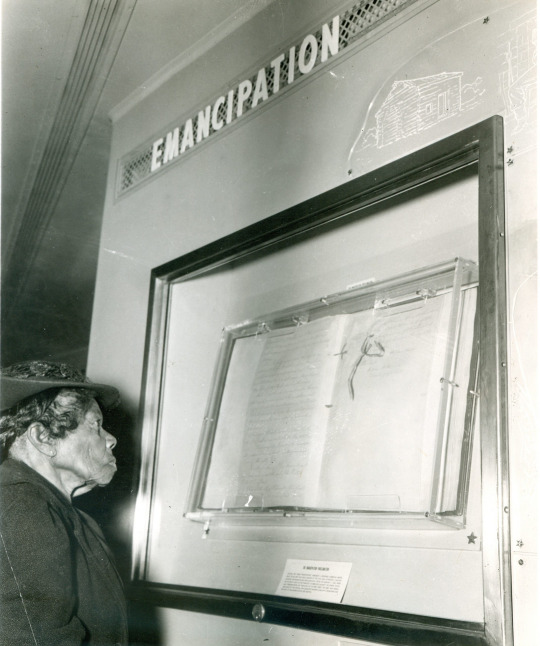
Former slave Sally Fickland views the Emancipation Proclamation on the Freedom Train, 1947.
WE HONOR JUNETEENTH
#OTD 2021, Juneteenth named a federal holiday
By Miriam Kleiman, Public Affairs
On June 19, 1865, 2½ years after the Emancipation Proclamation, Maj. Gen. Gordon Granger issued General Order #3, informing the people of Texas that all enslaved people were now free. Texans were the last Americans to learn this.
Visit the National Archives in DC this weekend (June 18-20) to see General Order #3 and the Emancipation Proclamation! Details here.
This day became known Juneteenth, a combination of June and 19th, aka Freedom Day or Emancipation Day, it’s this country's oldest known celebration commemorating the end of slavery. On June 17, 2021, President Joe Biden signed a bill into law establishing Juneteenth as a federal holiday.

Excerpt from General Order #3:
The people of Texas are informed that, in accordance with a proclamation from the Executive of the United States, all slaves are free. This involves an absolute equality of personal rights and rights of property between former masters and slaves, and the connection heretofore existing between them becomes that between employer and hired labor.
Featured Document Displays June 18-20, 2022 ONLY
National Archives, DC:
‘Juneteenth’ Gen. Order # 3 - West Rotunda Gallery,
The original Emancipation Proclamation - East Rotunda Gallery
President Lincoln issued the Emancipation Proclamation on January 1, 1863, as the nation approached the third year of the Civil War and declared “that all persons held as slaves” within the rebellious states “are, and henceforward shall be free."

Pulitzer Prize-winning historian Annette Gordon-Reed’s NARA book talk online.
About that promised Emancipation...
Emancipation wasn't a singular event. There were many emancipation days as enslaved people obtained their freedom in the decades spanning from July 4, 1776 through the Civil War.
Despite its expansive wording, the Emancipation Proclamation was limited. The freedom it promised was dependent upon a Union victory in the war. It also only applied in 10 Confederate states, leaving more than half a million men, women, and children in bondage in parts of the Confederacy already under Northern control and in the loyal border states. Learn more about this landmark document here.
More online:
Press release: National Archives To Display Emancipation Proclamation and ‘Juneteenth’ General Order No. 3, June 18–20
National Archives Safeguards Original ‘Juneteenth’ General Order.”
Archives Staffers “Find” Original Juneteenth Order!
The “EP” at the National Archives, Pieces of History
#juneteenth#civil rights#blm#black history#civil war#freedom#no justice no peace#african american history#black lives matter#juneteenth celebration#otd
264 notes
·
View notes
Photo










The Second Day of the Battle of Gettysburg was on July 2, 1863.
#Second Day of the Battle of Gettysburg#2 July 1863#anniversary#US history#Gettysburg Battlefield Historic District#Gettysburg National Military Park#USA#Pennsylvania#summer 2019#landscape#countryside#American Civil War#US Civil War#cannon#Little Round Top#Devil's Den#flora#free admission#original photography
0 notes
Text
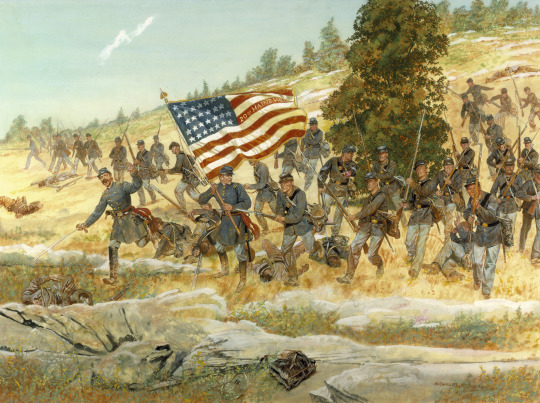
"The Twentieth Maine" by H. Charles McBarron.
The 20TH Maine being nearly out of ammunition and desperate to hold the flank of the Union forces was ordered by COL Chamberlain to charge the Confederate forces with fixed bayonets. With Chamberlain in the lead, the bayonet charge down Little Round Top was so unexpected and violent that it successfully pushed the Confederate forces back and destroyed the attack on the vulnerable Union flank. 2 July 1863.
23 notes
·
View notes
Text
The Canonical Five: Mary Jane Kelly

April 02, 2023
Mary Jane Kelly is who is known as Jack the Ripper’s 5th and final canonical five victim, however, there is much less information known about her upbringing compared to the other four women.
It is believed by many that the information we do know about Mary Kelly is embellished, with her having fabricated details that are known about her early life.
The man Mary Kelly had most recently been living with before her murder was named Joseph Barnett, and he later claimed Mary had told him she was born in Limerick, Ireland around 1863 and her family had moved to Wales when she was a child.
Supposedly Mary Kelly had told an acquaintance that she had been disowned by her parents, but she was close with her sister. It was said from Joseph and Mary’s landlady that she had come from a somewhat wealthy, good family. Joseph also claimed Mary confirmed she had seven brothers and at least one sister.
Mary’s landlord, a man named John McCarthy claimed she had received mail from Ireland, but not regularly. It was also believed that Mary was illiterate, as Joseph claimed she would ask him to read her the newspaper reports of the Jack the Ripper killings.
Though it’s been reported Mary had blonde or red hair, she went by the nickname of “Black Mary” suggesting she actually had quite dark hair. She also had blue eyes and some claimed to have known her as “Fair Emma.” It is estimated that Mary stood at about 5′7″ tall, and some said she was quite attractive.
On November 10, 1888, the day after her murder,
the Daily Telegraph
described Mary as “tall, slim, fair of fresh complexion, and of attractive appearance.”
In 1879, at around the age of 16, Mary married a coal miner named Davis or Davies who ended up getting killed 2-3 years later in a mining explosion. After this, Mary lived with a cousin in Cardiff, and this is where it is believed she started being involved in sex work.
In 1884, Mary left Cardiff and moved to London, where she worked as a domestic servant while lodging in Crispin Street, Spitalfields. In 1885, it’s believed she moved to the district of Fitzrovia.
Mary eventually began working in a high class brothel in the West End of London, becoming one of the most popular girls. She did quite well for herself and bought expensive clothes and hired a carriage at this time. Supposedly Mary had met a client named Francis Craig who took her to France, but she returned to London two weeks later, not having liked the France life.
It is believed that in 1885 Mary Kelly began drinking heavily. She moved around quite a bit lodging with different women and different men around this time.
It was on April 8, 1887, that Mary Kelly met Joseph Barnett, with the pair agreeing to live with each other after only knowing one another for a day. They lived in George Street, and soon a place called Little Paternoster Row, but were evicted for not paying rent and of drunk and disorderly conduct.
In early 1888, the two moved into 13 Miller’s Court, a single room a the back of 26 Dorset Street, Spitalfields. Mary had lost her key to the door, so she would bolt and unbolt the door from outside, putting her hand through a broken window by the door. A neighbour claimed Mary had broken the window when she was drunk, and a man’s coat often was used to act as a curtain.
It was said by Mary’s friend Lizzie Albrook, that Mary was sick of how she was living in 1888 and wanted to go back to Ireland. Her landlord said that she was a quiet woman when she was sober but very noisy when drunk. When Mary was drunk she often could be abusive to people, and was nicknamed “Dark Mary.”
Joseph lost his job as a fish porter in July 1888 due to committing theft, and because of this, Mary turned back to sex work. Mary would often let other sex workers sleep in their room at night when it was really cold because she did not have it in her to refuse them shelter.
It is believed that on October 30, 1888, Joseph moved out as him and Mary got into a fight about a sex worker named Julia sharing their room with them. Between November 1 and November 8, Joseph visited Mary almost everyday, sometimes giving her money.
The last time Joseph visited Mary was between 7-8 pm on November 8, 1888. Joseph claimed Mary was with her friend, Maria Harvey and that he did not stay long. He also apologized to Mary for not having any money to give. It is reported that both Joseph and Maria left Miller’s Court at the same time.
Joseph went back to his lodging house and played cards, falling asleep around 12:30 am. Before Joseph left Mary that night, her friend Lizzie Albrook also visited. Lizzie claimed Mary was sober.
In the evening, Mary reportedly had one drink in the Ten Bells public house with a woman named Elizabeth Foster. Later on, Mary was seen drinking with two other people at the Horn of Plenty pub on Dorset Street.
A sex worker named Mary Ann Cox, who also was a resident of Miller’s Court claimed to have seen Mary going home drunk with a stout, ginger haired man, around the age of 36 at 11:45 pm. The man was wearing a black bowler felt hat, had a thick moustache, had blotches on his face and was holding a can of beer.
Mary Ann actually had spoken to Mary Kelly, they both said goodnight. Mary Kelly then entered the room with the man. Mary Ann heard her singing the song, “A Violet from Mother’s Grave.” She was still singing when Mary Ann left her place at midnight, and when she returned an hour later around 1 am.
Elizabeth Prater lived in the room directly above Mary Kelly. She reportedly went to bed at 1:30 am, and the singing had stopped.
A man named George Hutchinson who knew Mary, claimed he had met up with her around 2 am on November 9, 1888 on Flower and Dean Street. Mary had asked George for a loan of sixpence, though he claimed to be broke. George said Mary Kelly walked toward the direction Thrawl Street when she was approached by a man of “Jewish appearance.”
The man was looked to be about 34-35 years old and George said he was suspicious of him because while it did seem like Mary knew him, his appearance made him look suspicious in that particular part of town. It was also said that this man made an obvious effort to disguise his looks from George, having his hat covering over his eyes as he passed.
George provided police with a very detailed description of said man, and told them he had overheard Mary talking with the man, complaining she had lost her handkerchief, and the mysterious man gave her a red one that he had. George heard Mary say to the man, “Alright my dear, come along. You will be comfortable.” And then the two walked into 13 Miller’s Court with George following them, though George never saw either one of them again.
A laundress named Sarah Lewis also claimed she had been walking in the area to meet up with friends around 2:30 am, when she noticed two or three people standing near the Britannia pub, among the people was a nicely dressed young man with a dark moustache and he was talking to a woman.
Both the man and woman appeared to be drunk and there was a poorly dressed woman standing near them. Opposite from Miller’s Court, Sarah said she saw a stout looking shorter man standing at the entrance to the courtyard. Sarah also saw an obviously drunk woman with a man further up the courtyard.
Mary Ann returned to her room around 3 am that morning and claimed she did not hear or see any light coming from Mary Kelly’s room at the time. She did think she heard someone leaving at around 5:45 am.
Elizabeth Prater who lived in the room above Mary Kelly and Sarah Lewis who was sleeping at 2 Miller’s Court that night both reported hearing a faint cry that said “Murder!” between 3:30 and 4 am, but didn’t do anything about it because this was common to hear cries in the area. Sarah Lewis said it was only one scream so she did not think much of it. She also claimed she did not sleep that night and heard people coming and going out of the court throughout the night.
Elizabeth Prater said she left her room at 5:30 am to walk to the pub for a drink, but saw nothing out of the ordinary.
On the morning of November 9, 1888, Mary’s landlord sent his assistant to collect the rent. Mary herself was 6 weeks behind, owing 29 shillings. Shortly after 10:45 am, the assistant knocked on her door but got no response. He tried to then turn the handle, but the door was locked. He looked through the keyhole but did not see anyone in the room.
Using the broken window, he peered inside the room and found Mary Kelly, completely mutilated lying on the bed. She was estimated to have died 3-9 hours before she was discovered.
The assistant ran to tell the landlord, and then went to inform the police. The assistant immediately told the police it was the work of Jack the Ripper. A surgeon came to look at the body, and police gave orders to prevent anyone from entering or exiting the yard (I know, impressive for 1888 police work.)
Bloodhounds were sent in, but it appeared to be impractical. It appeared that women’s clothing had been burning, and authorities believed Mary Kelly’s clothes were burnt by the murderer to provide light so they could see what they were doing.
Joseph Barnett identified Mary Kelly’s body, he could only identify her by the ear and her eyes due to the severe mutilation.
The mutilation done to Mary Kelly was the most extensive of all of the Whitechapel murders, with many believing it’s due to the fact that the Ripper had more time to commit this one in a private setting.
During the autopsy it was noted that it most likely took 2 hours to perform all of the mutilations on Mary’s body, the death was further estimated to have occurred between 2 to 8 am.
Her body was found lying naked in the bed, her head turned on the left cheek. Her legs were left wide apart, the whole surface of the abdomen and thighs were removed and her abdominal cavity was emptied (but later said there was food found in it). Her breasts were cut off, her face was hacked beyond recognition, gashes occurring in all directions. Her ears were partly removed.
Her neck was cut through the skin and her other tissues were cut down to the vertebrae. Her air passage was cut at the lower part of the larynx. Her heart was taken. There was also blood splatters on the wall, lining up with her cut throat.
She had a superficial cut on her thumb, which some believe was caused while she tried to defend herself from her attacker.
It was believed during the autopsy that Mary Kelly had been killed from a slash to her throat, and the mutilations were performed after she had died. It was not believed that the murderer had any medical knowledge.
The inquest into Mary’s death began on November 12, 1888. After testimony, the jury had a short deliberation and the verdict was that Mary Kelly had been murdered by a person or persons unknown.
Police did house to house questioning trying to get answers as to who murdered Mary Kelly. A few people claimed to have seen Mary on the morning of November 9, after she had supposedly been murdered, though police could not find anyone to corroborate those sightings, as well as the descriptions of Mary didn’t match.
On November 10, 1888, Mary’s murder was linked to four other murders: Mary Ann Nicholas, Annie Chapman, Elizabeth Stride, and Catherine Eddowes. There was also an offender profile made, which stated the killer was an eccentric person, who was in an extreme state of satyriasis while performing the mutilations on Mary and the four previous victims.
There were no other similar murders after Mary Kelly’s and a lot of people believe she was the final victim of Jack the Ripper. Most believe these Whitechapel murders ended due to the killer dying or going to prison.
Over 100 years after the Whitechapel murders, two authors named Paul Harrison and Bruce Paley theorized that Joseph Barnett, Mary’s partner, had actually murdered her during a jealous rage. They took the theory farther, stating that perhaps Joseph also murdered the other 4 canonical five, trying to scare Mary from engaging in sex work.
Others believe Joseph did kill Mary, but only Mary and had tried to make it look like a Jack the Ripper killing to avoid being captured. The fact that Mary was found lying naked on her bed, with her clothes folded on a chair leads many to believe that her killer was someone she knew or who she thought was a client.
Some people do not believe Mary Kelly was a victim of Jack the Ripper at all. Mary was assumed to be around 25 years old, much younger than the other victims who had all been in their 40′s. Also, her mutilations were more extensive than the other four, she was killed in a private location and her murder occurred 5 weeks from the previous killings which had all occurred within a month.
In 1939, author William Stewart theorized that Mary might have been killed by a midwife, “Jill the Ripper” in which Mary was going to have an abortion. Stewart believed perhaps the midwife had burned her own clothes, putting on Mary’s and that’s why people the next morning believed they saw Mary after she had been killed.
Mary Kelly was buried on November 19, 1888 in St Patrick’s Roman Catholic Cemetery in Leytonstone. None of her family members could be found to attend her funeral. The inscription on her grave reads, “In loving memory of Marie Jeanette Kelly. None but the lonely hearts can know my sadness. Love lives forever.”
#unsolved#UNSOLVED MYSTERIES#unsolved crime#unsolved murder#unsolved case#murder#jack the ripper#london#canonical#five#last#victim#whitechapel#murders
19 notes
·
View notes
Text


The daily citizen. J. M. Swords, proprietor. Vicksburg, Miss. Thursday, July 2, 1863 — Library of Congress
3 notes
·
View notes
Photo

Here’s a review of Vol. 2 of Les Misérables, the version published by West & Johnson (aka Confederate Les Misérables.) This review is wild. They thought that the convents digression was good but the Waterloo digression was too much. They are mad that Jean Valjean is allegedly in love with Cosette. They seem to think that Javert is too heavy-handed a character.
Source: the Richmond Enquirer, 10 July 1863
Les Miserables — Cosette
The second part of this voluminous work, of Mr. Victor Hugo has been reprinted by Messrs. West & Johnston [sic].
It is a continuation of "Fantine and is itself to be continued in three other parts, — We think it better and more artistic than Fantine; full of powerful descriptions, and thoughts which are sometimes noble and sometimes monstrous, often original, more often extravagant; but generally expressed with a rare and impassioned eloquence.
We have here a continuation of the fortunes of the escaped convict, Jean Valjean, and of the little Cosette, a child now of eight years, the daughter of Fantine. [. . .I’ll leave out their plot summary excepting a few points] This man, as before, proves himself the only perfect and truly angelic character in the book. [. . .what, is Myriel not angelic?. . .]
But once more he is recognized by the inevitable police officer, Javert, that preternaturally hateful impersonation of “Society.” Once more “human society repels him” — “human society howls upon his track,” &c. — [. . .]
Next comes the escape from the Convent — Cosette in a basket, Valjean in a coffin; in which coffin he is absolutely lowered into a grave, and shovels full of earth (to the number of four) thrown upon him, after which he is disinterred. There is a very long and interesting description of this Convent, one of the strictest in the world, named of the “Perpetual Adoration." [. . .]
Now one of M. Victor Hugo's monstrous imaginations is to make this old man of fifty-five fall in love with the little girl of eight years old. "It is something," he says, "very incomprehensible, and very sweet, this grand and strange emotion of a heart in its first love. Poor old heart, so young!" We doubt that it is sweet; but admit that it is incomprehensible.
More than one-fourth of this volume is occupied, strangely enough, with a minute narrative of the battle of Waterloo, which was fought eight years before the date of the story. This description is eloquent, after the style of eloquence of M. Victor Hugo — a style which we candidly avow we do not affect. For example, [. . .]:
"But what is that to the Infinite ? All this tempest, this cloud, tins war, then this peace. All this darkness, disturb not for a moment the light of that ‘Infinite Eye,’ before which the least of insects leaping from one blade of grass to another, equals the eagle flying from spire to spire, among the towers of Notre-Dame."
Eloquent, but absurd; because nobody ever said that a battle disturbs the Infinite Eye; and further because, since Notre Dame was first built, a thousand years ago, no eagle ever flew amongst its towers.
Now I have to break to show why I cannot transcribe the following portion:

Resuming:
We are decidedly of the opinion that Waterloo was not fought altogether to this end; and M. Hugo might as reasonably say the Saviour was crucified in order that an old woman might sell an ebony crucific [sic], for twelve sous, in the Place du Pantheon, on Easter Sunday, 1863.
Yet, with all this, Cosette is a most striking and remarkable production, and will not only engage but enchain attention.
The other three parts are promised in the month of August.
12 notes
·
View notes